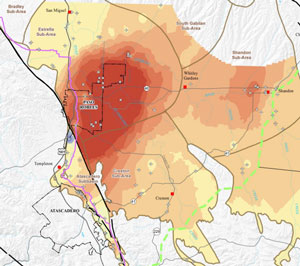Supervisors approve ag water conservation offset ordinance
By HEATHER YOUNG
 Program to replace urgency ordinance
Program to replace urgency ordinance
In another hearing about what to do about the severity of the Paso Robles Groundwater Basin, the San Luis Obispo County Board of Supervisors approved, 3-2, an ordinance creating an Agricultural Water Conservation Offset Program. supervisors Frank Mecham, Bruce Gibson and Adam Hill voted in favor of the motion, while supervisors Debbie Arnold and Lynn Compton. The First and Fifth districts, served by Mecham and Arnold respectively, both cover portions of the Paso Robles Groundwater Basin.
“My point is something’s coming. It’s coming anyway. I can tell you now, I don’t like this anymore than anyone else does,” Mecham said. “If you don’t think the state will step in, you roll the dice on that one, I don’t want to.”
The board was given a tight timeframe to give direction to the county in order to have the draft environmental impact report released and circulated for 45 days. The urgency ordinance adopted for the Paso Robles Groundwater Basin expires on Aug. 27. The adoption of this program will continue the elements of the urgency ordinance and stipulates, per Mecham’s motion, the following:
- New agricultural development must be water-neutral: the plantings must be offset by an equal amount of conservation, one for one.
- No new vested rights: in the urgency ordinance, hundreds of new plantings were exempted from the ordinance under a vested rights process that provided that if agriculturists could prove they had made significant investments in new plantings, they could be planted anyway.
- Sunset upon adoption of a groundwater sustainability plan: the ordinance will expire when a groundwater sustainability plan is adopted, which is required to be in place by 2020.
- It only applies to the Paso Robles Groundwater Basin.
Arnold asked Mecham if he would be willing to add an exemption to allowing those planting 50 acres, to which he said no. She then asked if he’d be willing to give an exemption to those bringing in water from another source. He said no to her suggestion.
“I absolutely think we need to come up with some solutions,” Arnold said. “We absolutely have a problem. I am not in denial that there is a problem. … The problem in the way that I see it, in the last decade we’ve seen some development of very large tracts of agriculture, we’ve also had a growing city — Paso Robles.”
Arnold offered several different solutions such as the exemptions she requested from Mecham, who made the original motion. She said that she sees relief when water comes from the Nacimiento Water Project.
Supervisor Gibson said, “I’m having a hard time reconciling your statement that you are not in denial with your inability to take on any kind of meaningful kind of action and I’d like to know from you exactly how your proposals are even going to start to solve the problem. The cavalry in the distance is not our problem. The dust in the wells is what we’ve got to worry about. I’m sorry but I don’t buy what you’ve laid out.”
“I just feel that any sort of urgency ordinance at all … currently protects the exploiters,” Compton said.
The board had many options before it, including applying the program to the Los Osos Groundwater Basin and the Nipomo Mesa Management Area as well as the Paso Robles basin or to have no offset program at all, allowing the urgency to just expire in August.
“I’m opposed to having any of these offsets. I’d love to see this urgency ordinance go away,” said Mike Ryan of Creston, adding that he’s seen more grapes going in during the last few months than the area would have in the five years if the urgency ordinance had not been adopted. “You’re done more to damage, than to help.”
Atascadero resident Gary Kirkland questioned the deed restrictions, asking what it does to property values.
“You’re taking away people’s property rights,” Kirkland said. “So we end up with the idea that you don’t own your property, you just lease it from the county. Your property tax is your lease.”
“I hear a lot about property rights and property values, what I don’t hear is anyone talking about responsibility,” Hill said. “We are trustees. We are responsible for whatever we possibly can do to stop the bleeding. All we can do is do what we can to see that the problem doesn’t worsen.”
Major ag offset program steps:
- Determine water amount currently used
- Determine acreage and water use of new crops
- Proximity analysis required on a case by case basis
- Evaluate drawdown impacts on neighboring irrigation and domestic wells to demonstrate that new groundwater pumping will not have the effect of lowering well levels in the area of the new pumping
- Issue Offset Clearance and conduct third-party monitoring. As part of the Offset Clearance, deed restrictions and property owner agreements will be recorded
The final approval will come in the summer after the Draft EIR is circulated and comments received from the public. County Planner Xzandrea Fowler said that it will most likely be released sometime in March.









